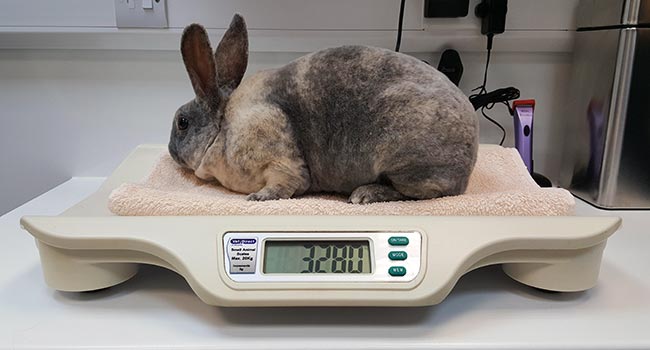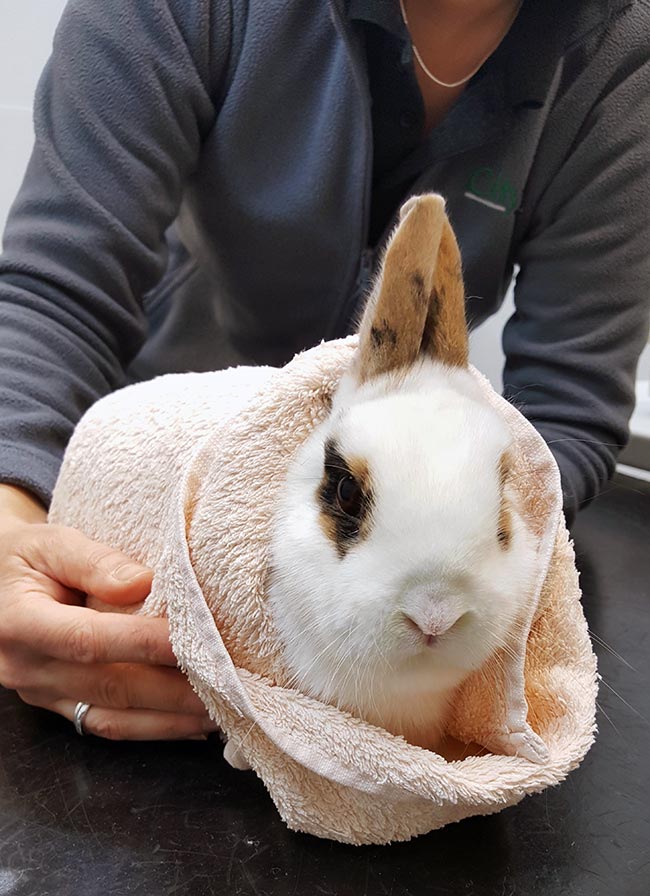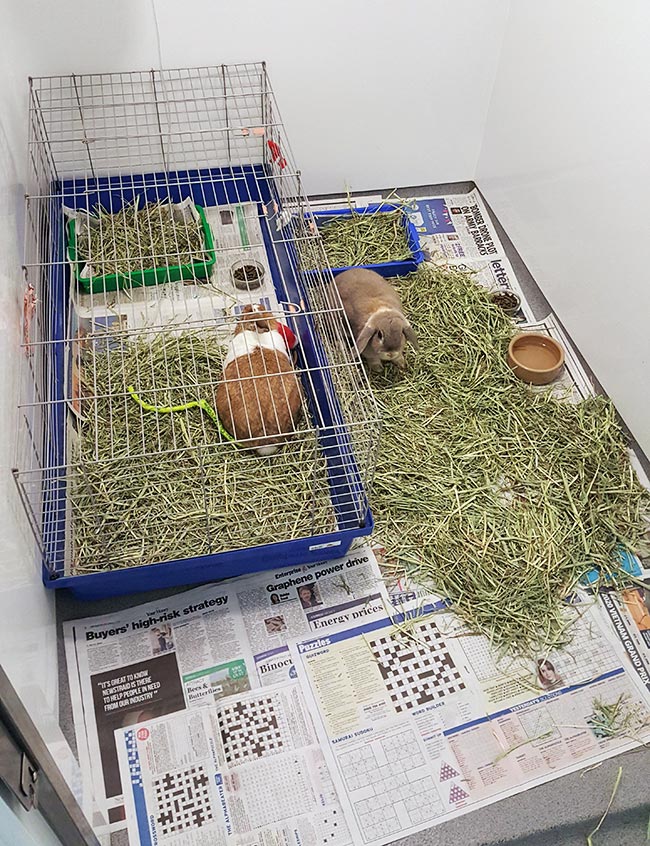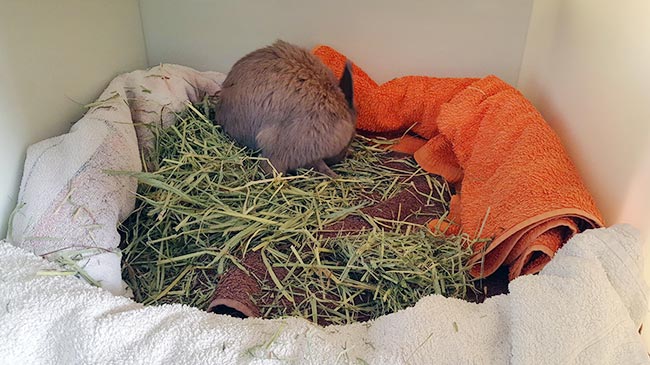11 Apr 2022

Figure 4. Very fractious rabbits may benefit from gentle wrapping in a soft towel.
Rabbits are regular visitors to most veterinary clinics, either for routine prophylactic consultations or medical and surgical procedures.
It is important to make sure veterinary staff are aware that the needs of rabbit patients can differ greatly from those of dog and cat patients. These needs will affect all aspects of their care – from the moment they enter the practice, through the consultation, and on to possible hospitalisation and treatment.
Their welfare should be considered at every stage – including how a rabbit experiences travelling to the practice, how it is handled once it arrives and how it is hospitalised, taking in consideration it is a prey species.
This article will explore and discuss how to reduce stress in rabbits in practice. Hopefully you will find it helpful with regards to not only how to improve rabbit welfare in practice, but also on how to prepare owners bringing their rabbits into the practice.
Rabbit owners may travel far and wide to seek veterinary treatment for their rabbits with a vet they trust.
Whether our rabbit patients have come to us from “just down the road” or further afield – especially in the case of referrals – they are going to experience a certain degree of stress during transportation.
Rabbit owners are also likely to worry about transporting their rabbit and will benefit from our reassurance that they can take measures to help their animal feel as comfortable as possible.
It is always best to get off to a good start before the rabbit leaves home. Positive reinforcement at home can play a big part in helping rabbits feel more at ease with their carrier and, eventually, with the travelling overall. It is good to start leaving the pet carrier open at home with the pet’s favourite foods and treats inside, and allowing gradual exploration of the carrier on the rabbit’s own terms.
Owners should be advised to start this desensitisation some time before they need to bring their rabbit into the practice. For example, the receptionists or the nursing team could suggest this during the first contact with the practice while registering the rabbit.
This approach may not always be possible, as many rabbit patients’ first contact with the clinic may be for an emergency treatment. But otherwise, it is a good discussion to have early on.
When the time comes to transport the rabbit to the clinic, further measures can be taken to help reduce stress levels – such as bringing the rabbit with its companion, and ensuring the vehicle is kept cool and has good ventilation.
Avoiding travelling in the hottest part of the day is advisable, as rabbits can overheat quite easily. Owners must also provide fresh water and hay during transportation, and ensure the carrier is large enough for the rabbit and its companion to move around and lie down comfortably.
The carrier should be lined with newspaper or other bedding material to prevent the rabbits becoming soiled during the journey. Partially covering the carrier with a blanket or a towel will also help the rabbits feel safer.
It is advisable to secure the carrier in the footwell or with a seatbelt to ensure the journey is safe, and regular checks should be made throughout the journey – especially if the rabbits are travelling in from quite a distance.
Herbal remedies and pet calming sprays containing valerian – among other ingredients – can be used to help the rabbits to relax during the transportation and other stressful situations. A study from the University of Bristol found the use of calming spray was associated with a significant decrease in heart rate and a significant increase in the number of positive behaviours the rabbits exhibited when used in acute stress situations (Unwin et al, 2020). The author of the article also has anecdotal evidence suggesting owners who have used a herbal remedy during transportation noticed their rabbits were calmer.
Staff working on reception should be confident with their basic knowledge on rabbit management and on how to advise owners. This will help to support the concept that rabbits and their welfare are a priority from the first contact.
Once the rabbit has arrived at the clinic, it is up to us – the veterinary team – to ensure it can be as relaxed and settled as possible while waiting to be seen.
In an ideal world, a separate waiting area for rabbits and other prey species would be the gold standard; however, this is often outside the realms of most veterinary practices and simple alternative solutions can be considered.
A simple shelving unit setup (Figure 1) allows rabbits to sit in close proximity to their owners while being sheltered from the prying eyes of canine and feline patients. Carry boxes can easily be slotted into the shelving unit, resulting in a more secluded environment.

If this is not possible, it would be ideal to direct the owner and their pets into a spare, empty consult room, or through to another quieter area of the hospital (away from predator species).
In practice, herbal remedies can also be made available in the waiting room for owners to use if necessary. Clients can use a piece of paper or a fabric sample, spray the calming spray on it and attach it to rabbit’s carrier or pop it in the basket to help them feel more settled.
Consideration can also be given to booking rabbit consults early in the morning, before any cats, dogs or ferrets have been seen. This reduces the presence of a “predator” species scent in the waiting room and consult room that could be picked up by the rabbit.
If several consult rooms are available, keeping one room free for prey species only will help to alleviate potential stress from the scent of predators.
Whether rabbits are visiting for a medical condition or for an annual vaccination and health check, it is important to ensure they feel as comfortable and secure as possible.
A non-slip surface on which to examine the rabbit is very important to help reduce the risk of injury. Rabbits have very powerful muscles in their hindlimbs, but a very light and delicate skeleton that is easily damaged. Placing a vet bed or towel on the otherwise slippery examination table may help the rabbit to feel more secure, improving its comfort (Figure 2).

The same idea can be applied to plastic weighing scales by placing a towel or vet bed on top before weighing the animal (Figure 3).

Nervous rabbits may be examined either on the floor or while still sitting in their box. Advising owners to buy a carrier that can be opened from the top will aid the examination and avoid the rabbit having to be over-handled to get it through the carrier’s front door.
Temperature, pulse and respiration can be gained with minimal handling while still inside the carrier, and ear and eye examinations can be carried out. Care must be taken when obtaining temperature in all rabbits as they can easily suffer rectal tears if suddenly moving.
Very fractious rabbits may benefit from gentle wrapping in a soft towel (“bunny burrito”; Figure 4). This can help to perform an intra-oral examination, check the ears or give oral medications without the need for scruffing or forcefully restraining the rabbit, causing pain and leading to increased stress. With these animals, the physical examination can be carried out on the floor rather than on the table to prevent unwanted injuries and sudden jumps off the table.

Once the rabbit has been examined and its case discussed, it may be allowed to roam freely in the consult room (if safe to do so) with a blanket or vet bed, some hay and its carrier on the floor (Figure 5). The rabbit should be feeling a little calmer now the examination has ceased, and will hopefully start exploring and familiarising with the strange environment.

All of these aspects taken into consideration should make for a much more comfortable consult experience for rabbit patients and their owners, who will also relax seeing that the needs of their beloved pets are taken into consideration.
Should the rabbit be admitted into hospital, further adjustments can be made with regards to reducing stress and making their stay more comfortable.
Rabbits should be hospitalised away from cats, dogs and any other predator species, such as ferrets, birds of prey and large snakes; and, when possible, together with their companions (Figure 6). This will encourage a more natural behaviour during hospitalisation, making the treatment more efficacious and the recovery quicker.

Kennels should be as large as possible, where medical condition allows – especially in the case of suspected or confirmed gut stasis, as exercise helps to stimulate gut motility. Periodic access to a larger space throughout the day – such as a large indoor rabbit/guinea pig cage, or a free run around the ward – is also another potential option to consider.
However, some cases will require more restricted kennelling. Rabbits suffering from illnesses such as paresis of the hindlimbs, torticollis, paralysis, and incontinence will likely benefit from a much more enclosed and padded environment (Figure 7).

The kennel should be supplied with a cardboard box, or similar, as a hide – this will reduce stress and give the rabbit an option to hide away between ward rounds. A newspaper-lined litter tray should also be provided if kennel size will allow it, as many rabbits are now litter trained and will feel happier with the option to use a tray.
Plenty of hay to eat and forage should be provided to all hospitalised rabbits at all times. Rabbits naturally eat constantly throughout the day – and this must be facilitated in hospital to encourage normal behaviour and gut motility, and prevent ileus and the associated pain and discomfort that may follow. Always offer a sturdy (ideally ceramic) water bowl and a water bottle – studies have shown rabbits will drink significantly more from a bowl as opposed to a bottle (Tschudin et al, 2011).
A variety of food items and critical care formulas for herbivores should always be available at the clinic. Otherwise, it is possible to ask owners to bring some of their rabbits’ usual food with them. A sudden change of diet can be quite stressful, and may result in changes to gut bacteria and subsequent dysbiosis. Bringing a “packed lunch” is something that can also be mentioned to owners when booking the appointment.
Seeing rabbit patients early in the day is also beneficial if they end up being admitted, as more time is available to observe them during daylight hours, and carry out a full assessment of behaviour and pain status before handing over to the next shift and on-call colleagues.
Rabbits are prey species, so tend to hide signs of illness and pain. Rabbits showing signs of pain or discomfort will usually be quite motionless and remain in one corner of their kennel, and may display a hunched position. These rabbits will be reluctant to explore their surroundings. Other signs of pain may include reduced appetite, teeth grinding, and reluctance to be approached or handled.
It is important to ensure the rabbit is pain free and that a good analgesic protocol is used to prevent discomfort. Moreover, pain and stress can lead to several short-term and long-term problems, such as ileus and immunosuppression. Regular pain scoring should, therefore, be carried out while the rabbit is hospitalised – the Rabbit Grimace Scale is the only available pain scoring system available for this species.
Pain relief for rabbits is, in itself, a topic for much more detailed discussion outside the realms of this article. However, ensuring a solid plan is in place for analgesia in rabbit patients – and that all staff are aware of higher doses of some analgesics for rabbits – is very important with regards to maintaining their welfare while hospitalised.
It is also important to remember that if a condition is painful in cats and dogs, it is likely to be painful in rabbits as well – and this should be addressed to the best of our knowledge.
While accommodating our rabbit patients may feel a little overwhelming at first, much can be achieved with regards to improving rabbit welfare in practice and with quite simple adjustments.
Not only will relaxed rabbits be easier to handle and monitor as inpatients and in our consulting rooms, but they will also have less chance of developing stress-related-health problems alongside their initial illness.
Getting owners involved in preparing their rabbits at home, for travelling and visiting the practice not only helps rabbits feel more at ease, but hopefully allays fears owners may have about bringing their pet in and builds their confidence in our abilities.
Practising high standards of rabbit welfare in-house should make our facilities the “go-to” practice when it comes to caring for these beloved companion pets.